How the hell does Zappos show you ads about the shoes you looked at a few days ago?
Your friend just told you about a company a few days ago, and now you’re seeing their ads all over your Facebook News Feed. What’s going on?
You almost bought something from Amazon, but decided to leave after you put the item in your cart. Why are you seeing ads for 20% off now?
The answer is retargeting.
Retargeting ads are an incredibly powerful marketing tool. These ads can be one of the best ways to attract the right customers and capture additional revenue for your business.
But enough with the explanations. Let me show you what retargeting ads can do:

We spent $4,168.19 and made $9,365.00 from a recent retargeting campaign for AppSumo. That’s a 224% ROI. 💰
In fact, a 2x (or higher) ROI is common with retargeting ads.
What’s even better: it’s easy to get started with retargeting campaigns even if you haven’t done much paid advertising in the past.
Ready to buckle up and learn more? In this guide we’ll cover:
- What Are Retargeting Ads?
- How Does Retargeting Work?
- 3 Types of Retargeting Ads
- Pixel-Based Retargeting vs. List-Based Retargeting
- The 3 Most Popular Places for Retargeting on the Web
- My Step-By-Step Guide to Creating and Setting up Retargeting Ads
- Spending Your First $100 on Retargeting Ads
- Next Steps for Retargeting Ads
| BONUS: My 6-step cheatsheet to epic Facebook ads |
What Are Retargeting Ads?
Retargeting ads are served only to people who have already visited your website or those you already have a relationship with (for example, people on your mailing list).
Compare this to other types of ads, which typically just show to anyone you define on a certain website, or within a certain target demographic. In other words, you assume they might be interested in your material, but you’re not sure.
How Does Retargeting Work?
On most sites, 95% of visitors leave without buying or converting (like signing up for your email list).
Retargeting helps you win back these visitors — and turn them into customers, email subscribers, and more.
Diving into Noah’s tech talk time, retargeting works when someone visits your website and you have a retargeting cookie on your website. When your visitor open a new website with ads, the ad will pick up on the cookie and display a retargeted ad.
The key to retargeting is, it’s MUCH easier to advertise and sell to people who already like you vs. brand new customers.
Which are you more likely to buy?
- The pair of shoes you searched for 10 times, read six reviews about, and then see a discount code if you purchase today
- A random pair of shoes now your style, your size… and for the opposite gender
The key difference between retargeting and regular advertising is you already KNOW the customer is interested.
3 Types of Retargeting Ads
Retargeting ads can be used at all stages of your sales funnel.
To simplify things, there are three main types of retargeting ads I recommend running:
- Content ads
- Lead generation ads
- Direct sale ads

1. Content Retargeting Ads
Content ads push viewers to a helpful article on your site. There’s no sale to be made, or sign-up for an email list as your end goal. A good us case for a content ad is if you just published a new blog post and you want to make sure past visitors don’t miss out.

2. Lead Generation Retargeting Ads
I predict content upgrades will lose effectiveness in 2017.
But for now… they still work pretty well. Today, content upgrades are an effective way to generate leads for your business.
To show you how AppSumo uses content upgrades, check out our free business idea cheat sheet ad below.

Lead generation ads can also be direct links to a free download form for a software trial, or even just a link to your email newsletter subscription page.
No matter how you aim to generate leads, the key is to create something of VALUE for your customer (and help them solve a problem) with your free product or software. 🔑
3. Direct Purchase Retargeting Ads
Direct purchase ads retarget users with the goal of bringing them back to your product purchase page. With these ads, you want to get people to click on your ad and take a next step through your funnel to purchase.
It can be best to target these ads at users you already have a fairly strong relationship with: for example, those on your mailing lists.
Even better, you can offer a percentage off coupon for users who finish their checkout. For example, if a user comes to your site, sees a product, and then abandons your site, you can serve them ads for a discount on the product.
Pixel-Based Retargeting vs. List-Based Retargeting
In order to successfully run retargeting campaigns, you first need some data to help you identify who you’re going to retarget. There are two main types of data used in retargeting campaigns:
- Pixel-based
- List-based
Pixel-Based Retargeting
Pixel retargeting tends to be the most common type of retargeting. Here’s how it works:
- A user visits your website
- A tracking pixel leaves a cookie in the user’s browser
- When they leave your site, you can retarget ads at the using a retargeting platform like Google or Facebook
I use Facebook retargeting ads on my own site in a few places. For example, check out my newsletter join page.
When you look at the code, you see this snippet:

Anyone who goes to my email newsletter page will be automatically tagged with a retargeting pixel from Facebook. This way, I can serve my retargeted users on Facebook applicable ads.
One of the killer things about pixel-based retargeting is that once your campaign is set up, you can begin to remarket to someone literally as soon as they leave your website.
Top Tip: I’m currently using pixel-based retargeting to grow my email list and seeing incredible results!. When a reader visits OkDork I then retarget them with ads directing to my email newsletter page https://okdork.com/email-newsletter/. This is converting at ~ $1/sign up.
List-Based Retargeting
You can also create retargeting campaigns targeting people who are currently on your email list, or targeting email addresses of current customers.
Once you have a list of either your current customers or email subscribers, here’s how you specifically set up list-based retargeting works:
- You upload a list of email addresses
- You create an ad you’d like to target towards these users
- The ad platform serve retargeting ads just to users who match the email addresses you uploaded
With an understanding of how to target your customers, the next step is understanding where to target your customers.
The 3 Most Popular Places for Retargeting on the Web
1. Facebook Retargeting
Using Facebook, you can set up retargeting ads to reach an audience of people who have visited your website.
For example, if you visited AppSumo in the past, you might have seen me making a weird face at you in the ad below.
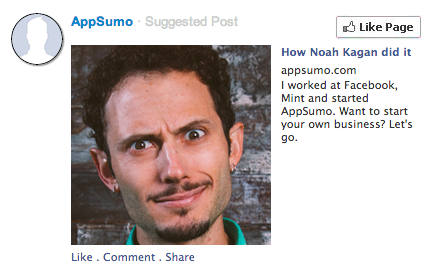
Here’s a bonus tip: You can even retarget people who take action on your website.
For example, when a user signs up for a content upgrade on one of my articles (like this), I use my opt-in plugin Sumo to fire a Facebook tracking pixel on successful subscribe.
Here’s what this looks like in my website backend setup:
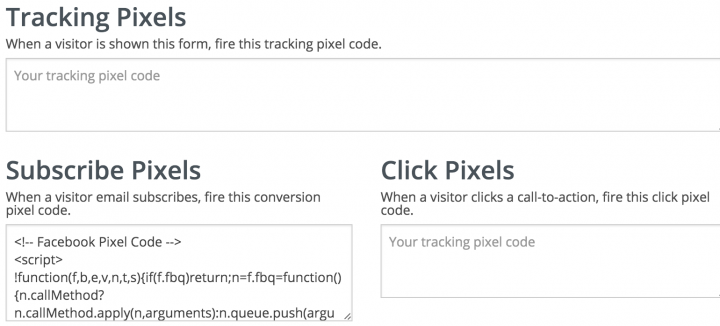
Specifically, the user is redirected to my Bonus page, and the Facebook pixel is fired. This gives me the opportunity to pitch subscribed readers special things on Facebook.
In your own business, you could use this as an opportunity to upsell or showcase additional products or services.
2. Google Display Network Remarketing
Google uses the term “remarketing” for their Display Network. This is very similar to retargeting on other platforms, like Facebook.
The big difference: Instead of your ad appearing on a specific site (like Facebook), your remarketing ads will appear on any sites that have Google’s Display Network configured.
It doesn’t matter if the site is a massive news site, your local taco shop, or even your own site. If you were on a website with Display Network remarketing, you might see an ad like the AppSumo one below.

To set up Google remarketing for your own business, check out the Google remarketing code instructions.
3. Twitter Tailored Audiences
At Sumo, we’ve seen the most profitable ads on:
- Facebook sidebar ads
- Facebook News Feed ads
- Google Image advertising
(We don’t do text ads — all of our ads contain images.)
Truthfully, we haven’t seen profitable ads within Twitter. But, the capabilities are there and Twitter calls it “Tailored Audiences.”
Here are a few guides to help you get started:
- Twitter’s guide to Tailored Audiences
- Twitter blog post: “Introducing the website tag for remarketing”
- Twitter blog post: “Website conversion tracking and remarketing made easier and more flexible”
What’s the ROI of Retargeting Ads?
200%.
That’s a good ROI benchmark for retargeting.
In other words, for every $1 you spend, aim to make $2.
Why 200%?
Because it’s been extreme doable in our tests at AppSumo, my tests for this blog, and elsewhere.
For most business owners and entrepreneurs used to the slim margins of traditional advertising, this may seem high. But if you follow the guide below reaching 200% will seem much easier.
Should you advertise to existing customers?
I use a retargeting campaign when:
- People visit Sumo or AppSumo, but don’t purchase a product
- I want to “upsell” my OkDork email subscribers a new blog post or article
- I want to grow an email list and get a visitor to subscribe
Retargeting current customers is uncommon — but I’ve seen results. Depending on the situation, I follow two philosophies about advertising to existing customers:
- Upsell: In my experience, it’s MUCH easier to sell to a current customer who knows my brand than try to convince a new customer who I am. If I’m trying to pitch a new product or article to an already-existing customer, the cost per click (CPC) is very low, which saves me money and has strong results
- Exclude: I don’t pitch to all my existing customers or readers. Often times, I’ll exclude them completely or exclude certain groups. After all, I don’t want to annoy my most loyal customers
When I do an upsell, I only show ads to people who have visited the site in the past 30 days. These customers are most receptive, and it means they’re most likely satisfied.
As you develop additional campaigns, Aaron Zakowki recommends creating different lists for customers so that can you can create specific and different messaging after they purchase.
My Step-By-Step Guide to Creating and Setting up Retargeting Ads
If I’m setting up retargeting in multiple systems, I like Perfect Audience. Their platform supports different types of retargeting campaigns from one, simple interface (including Facebook) which makes my life easier.
Similar to those of you who use Google Tag Manager as the one piece of code snippet for a bunch of different tools, Perfect Audience uses one pixel for multiple retargeting platforms so you only have to set it up once.
If you’re a beginner, it’s easiest (and least expensive) to focus on setting up retargeting ads directly within Facebook. Here’s how you get started.
Setting up a Retargeting Campaign on Facebook in 6 Steps
1. Set up Facebook Pixel
The first, and most important, step in kicking off a retargeting campaign on Facebook is installing the Facebook pixel on your site.
The Facebook pixel is a piece of code that you can place on your website to report conversions and build audience segments directly inside Facebook. Here’s a full guide to setting up a Facebook Pixel on your website.
2. Head over to Facebook Ads manager
Once you’re in Ads Manager, click the dropdown in the top left of the nav (next to Adverts Manager) and select Audiences:

This is where you’ll be able to specify EXACTLY who you want to target.
3. Create Your Custom Audience
Once you’re in the Audiences tab, click the “Create Audiences” → “Custom Audience.”
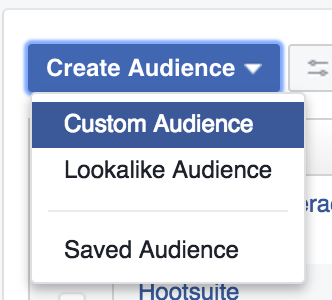
Next, you need to select how you’d like to create your audience:
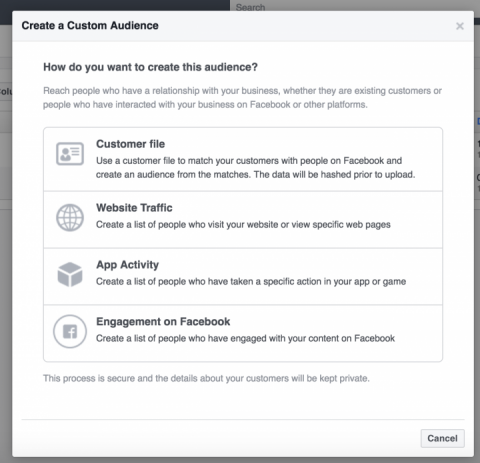
Facebook presents you with four options to create your audience. For this post, we’ll focus in on the “Website Traffic” option. (But if you’d perfect to create a list-based retargeting campaign, click on the Customer File option.)
On the next screen you have the option you have the choice five options to create your audience:
- Anyone who visits your website
- People who visit specific pages
- People visiting specific web pages but not others
- People who haven’t visited in a certain amount of time
- Custom combination
![]()
I tend to find specific ads work best, so I choose to target people who have visited a specific web page with ads relevant to that page.
For example: I might target anyone who visits okdork.com/podcast with an advert for my latest episode. This is likely to drive many more clicks than an ad targeting everyone who has visited OkDork.
Once you’ve made your choice, click “Create Audience” and you’re good to go and create your ads.
4. Create Your Advert
Next, click the big green “Create Advert” in the top right corner of Facebook Ads Manager:

5. Choose Your Objective
Now, you need to choose one of Facebook’s 15 marketing objectives for ads:
The option you choose here will depend on the type of retargeting ad you’re looking to run:
- Awareness = Content
- Consideration = Lead generation
- Direct Sales = Conversion
Choose the one which best suits your goal. If you’re just trying to push eyeballs to a blog post, pick awarness. If you want to push newsletter subscriptions, try consideration. And if you want to sell more of a product, pick conversion.
Next, give your campaign a name and create your advert.
Bonus: For a full guide to create incredible Facebook Ads (and the lessons I learned spending $3 mm on ads), click here.
6. Select Your Audience
With you advert all set up, it’s now time to choose the audience you’d like to target. You’ll want to select the audience you set up in Step 3.
To do this, click on the “Use saved audience” option and select the audience you just created:
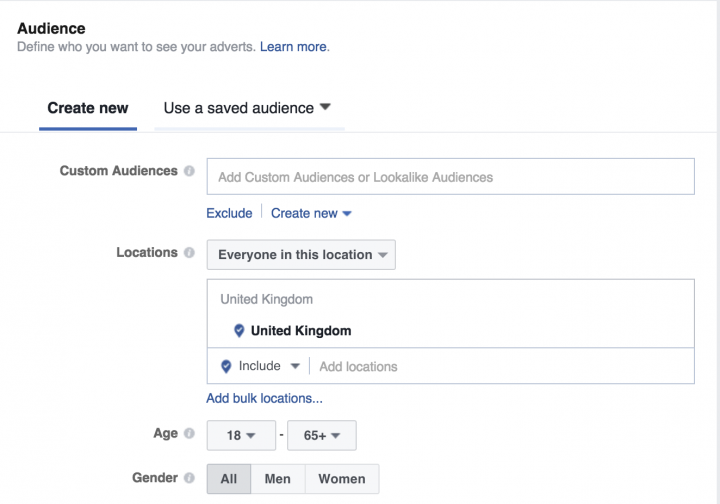
7. Put Your Ads Live
Once you’ve got your audience set up, you’re all set you go.
Congrats! Your retargeting campaign is ready to rock 🙂
Spending Your First $100 on Retargeting Ads
If you’re new to Facebook Ads or just retargeting ads, I’d recommend spending your first $100 as follows:
- $75 on Facebook Sidebar retargeting ads
- $25 on one News Feed ad
An ad in a Facebook sidebar will get shown way more often versus a News Feed ad. Repetition and frequency are your best friends in retargeting, since it may take a user multiple times to see the ad before they finally click.
At AppSumo, Sidebar ads have worked well because they’re shown more often than News Feed ads. With retargeting it generally takes a decent number of impressions to finally get someone to click and take an action.
Next Steps for Retargeting Ads
Warning: People who are coming from retargeting DON’T buy right away. Otherwise they would have bought or taken action when they were on your site the first time.
Commit at least 30 days to trying retargeting to fully measure your results.
Some people get impatient and think retargeting isn’t effective after a week. Even if it isn’t effective, this is why I recommend you only spend $100 so you don’t lose too much money.
Retargeting can be powerful no matter what your marketing goals:
- If you have a blog and want more subscribers, you can do retargeting
- If you want to upsell new products, you can do retargeting
- If you just want more readers for your content, you can do retargeting
Get started trying retargeting today. It could be one of the best channels you have for increasing your business.

74 responses to “How to Use Retargeting Ads to Gain a 200% ROI”
A big Huge ROI imagine 200% uhhh woooww!
Nice write-up! Retargeting ads on Facebook is one of the fastest ways to boost sales, conversion rates, and your bottom line. Implementing a good retargeting strategy can dramatically improve your paid advertising ROI
How is this 224% ROI? ROI = (Gains on investment – Cost of Investment)/Cost of Investment *100
They didn’t subtract the cost of investment. They did Gains/Cost directly… this is a common mistake. The ROI is more like 125%